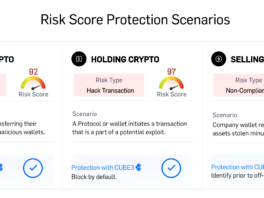
Content
Crypto Fraud Prevention: Complete Guide
As cryptocurrency adoption continues to rise, with over 560 million users worldwide, businesses are facing a growing number of threats to their digital assets and reputations.
In 2023 alone, the FBI’s Internet Crime Complaint Center received over 69,000 complaints related to cryptocurrency fraud, with reported losses exceeding $5.6 billion.
This staggering figure highlights the importance of taking proactive measures to protect your business from fraud.
In this guide, we’ll explore the impact of crypto fraud on businesses, including its effects on trust, revenue, and operational costs.
We’ll also outline the best strategies for fraud prevention, so with that in store, let’s dive in.
Understanding the Impact of Crypto Fraud on Businesses
Crypto fraud involves deceptive practices designed to exploit businesses and individuals, often leading to severe financial and reputational damage.
The consequences of fraud go beyond just monetary losses, they affect customer trust, brand loyalty, and operational efficiency.
For businesses operating in the cryptocurrency ecosystem, it is absolutely crucial to understand these broader impacts:
Impact 1: Loss of Trust and Brand Loyalty
Every incident of fraud destroys trust in the industry.
If a business is compromised, customer loyalty suffers, and the brand may be seen as unreliable.
This leads to significant downstream effects, including loss of customer lifetime value and negative brand perception.
Businesses often spend significant resources on marketing and customer acquisition, and a single fraud incident can undo months or even years of trust-building efforts.
Rebuilding this trust is extremely costly and time-consuming, especially if a business operates in a sector with tough competition.
Impact 2: Revenue Loss
The financial cost of fraud is immediate and substantial, but it often also results in ongoing costs associated with litigation, recovery efforts, and compensation.
Businesses may face chargebacks or be forced to repay lost assets, further impacting revenue.
Furthermore, fraud can lead to increased insurance premiums, higher transaction fees, and even loss of access to key financial services, as providers may view fraud-affected businesses as too risky.
Impact 3: Increased Operational Costs
Fraud incidents often disrupt day-to-day operations, resulting in downtime as the team works on response and mitigation.
There are also costs related to implementing remedial measures, which put a strain on business resources.
Fraud diverts resources away from core activities, slowing down growth and innovation.
Teams may need to dedicate time to forensic analysis, legal proceedings, and fraud prevention efforts, impacting productivity across the organization.
Broader Impacts
Crypto fraud is constantly evolving.
At the moment, the prevalence of fraud surpassed that of hacks, indicating a shift in focus from exploiting vulnerabilities in protocols to deceiving human users and businesses.
This trend makes fraud a growing priority for security strategies.
Unlike hacks, fraud often involves social engineering, which requires an entirely different approach to prevention, emphasizing awareness, training, and proactive detection.
How Businesses Can Protect Themselves from Crypto Fraud
To combat the rising threat of crypto fraud, businesses need a multi-layered approach that combines managing private keys securely, technological tools, employee training, and advanced security protocols.
Let’s take a look at some of these key strategies:
1. Use Advanced Security Practices for Businesses
Generic security advice like enabling two-factor authentication (2FA) is often targeted at individual users, but businesses require much more sophisticated measures.
For instance, multi-signature wallets should be used to secure transactions, ensuring that no single point of failure can jeopardize assets.
Additionally, key management systems should involve both automated and manual checks to prevent unauthorized access.
Businesses should also consider integrating hardware security modules (HSMs) and secure enclave technologies to protect cryptographic keys from unauthorized use.
By creating layers of access and using physical devices to verify transactions, the chances of successful fraud are significantly reduced.
Advanced encryption methods should also be employed to ensure that sensitive data cannot be accessed even if a breach occurs.
2. Use Real-Time Fraud Prevention Tools
For businesses involved in payments, finance, banking, managing wallets, or attracting investors, utilizing proactive fraud detection tools is an absolute necessity.
Platforms like CUBE3.ai offer pre-crime prevention mechanisms which identify suspicious activity before any damage occurs.
This technology uses machine learning to assign risk scores and flag potentially fraudulent transactions, helping to intercept threats in real time.
CUBE3.ai is particularly effective because it can monitor both Web2 and Web3 data, an important advantage in detecting fraud early.
This is especially significant because many scams actually originate in Web2 environments, such as email phishing or social engineering through social media, before they escalate into cryptocurrency fraud.
Additionally, CUBE3.ai uses behavioral analytics to identify anomalies in transaction patterns, such as unusual amounts, timing, or transaction recipients.
By continuously learning from historical data, these systems become better at recognizing the subtle indicators of fraud that might go unnoticed by human analysts.
This helps businesses stay one step ahead of attackers who adapt their tactics over time.
3. Provide Employee Training and Vigilance
Since many fraud tactics target human vulnerabilities, regular employee training is critical.
Businesses should train their teams to identify phishing attempts, imposter websites, and social engineering scams.
Make sure employees know to question unusual requests and escalate concerns for verification.
This awareness, combined with advanced monitoring, creates a stronger line of defense.
Training programs should be updated regularly to cover emerging fraud tactics, such as spear phishing or deepfake-based social engineering.
Interactive workshops, simulated phishing attempts, and regular knowledge assessments can be very effective in preparing employees to recognize and resist fraudulent schemes.
Employees should also be encouraged to use secure communication channels and avoid sharing sensitive information over unsecured platforms.
4. Implementing Role-Based Access Control
A critical step in safeguarding digital assets is limiting access to sensitive information.
Role-based access control (RBAC) ensures that employees only have access to information required for their specific tasks.
By limiting permissions and regularly reviewing access logs, businesses can prevent internal vulnerabilities from being exploited.
Implementing RBAC should involve conducting a thorough audit of all access points and ensuring that permissions are aligned with employees’ roles and responsibilities.
It is also advisable to integrate RBAC with centralized identity management systems that provide a clear audit trail of who accessed what, when, and why.
By using this approach, businesses can easily identify potential internal threats or policy violations.
5. Due Diligence on Partners and Transactions
Businesses should thoroughly vet partners, exchanges, and any other third-party service providers.
This involves verifying reputations, ensuring transparency, and looking for red flags such as unrealistic returns or pressure for immediate action.
Conducting this kind of due diligence can significantly mitigate the risk of engaging with fraudulent entities.
In addition, businesses should utilize blockchain analytics tools to track and verify the source of funds before engaging in any transaction.
These tools can help identify whether an address has been associated with previous fraudulent activities.
Establishing clear procedures for partner verification, including background checks and financial audits, can further reduce exposure to fraud risks.
Building relationships only with regulation-compliant partners also adds an extra layer of security.
CUBE3.ai: How to Prevent Crypto Fraud Before It Happens
At CUBE3.ai, we provide the most advanced tools in the industry, specifically designed to prevent crypto fraud before it ever happens.
Our solution monitors blockchain activities and assigns real-time risk scores to transactions, wallets, and smart contracts, enabling proactive interventions.
How CUBE3.ai Helps Prevent Crypto Fraud
- Inspector: comprehensive fraud risk scoring for transactions, wallets, and smart contracts in real time.
- Monitor: continuous real-time monitoring and fraud detection for addresses, wallets, and smart contracts.
- Sonar: real-time data feed and alerts of crypto crime across entire blockchain networks.
- RASP Smart Contract Firewall: Enable real-time, contract-level enforcement based on your custom fraud risk parameters.
Real-Life Examples of Fraud Prevention
To understand the impact of proactive fraud prevention, let’s look at recent examples where CUBE3.ai’s technology could have prevented significant fraud incidents if these companies had been using our solutions:
Aave Phishing Attack:
CUBE3.AI detected a phishing exploit targeting a high-value Aave wallet, flagging the attacker’s wallet weeks in advance. The attacker manipulated token approvals, resulting in $2.28 million in stolen assets.
Penpie Flash Loan Attack:
CUBE3.AI detected the exploit contract on Penpie just 32 seconds after deployment, revealing a flash loan attack that ultimately drained $28 million across Ethereum and Arbitrum.
Final Thoughts
As we can see, crypto fraud represents an evolving and persistent risk for businesses, but by understanding the broader impact and adopting a multi-layered security strategy, companies can significantly mitigate these risks.
Advanced tools like CUBE3.ai can provide a proactive edge, allowing businesses to identify threats before they turn into incidents.
Adopting a comprehensive fraud prevention plan not only safeguards assets but also helps build trust with customers and partners, positioning your company as a secure and reliable entity within the crypto ecosystem.
Employee education, advanced monitoring, due diligence, and proactive prevention all work in tandem to protect your business.
Don’t let your business be another statistic.
Start protecting your assets today by booking a demo with CUBE3.ai and fortifying your operations against the rising tide of crypto fraud.
FAQ
How to prevent crypto fraud as a business?
Prevent crypto fraud by using advanced security, real-time monitoring like CUBE3.ai, employee training, due diligence, and role-based access controls.
How to investigate crypto fraud?
Use blockchain analytics, review transaction patterns, and employ specialized fraud detection solutions to investigate and trace crypto fraud effectively.
How to spot crypto fraud?
Businesses should remain vigilant for sophisticated indicators of potential crypto fraud, including unsolicited offers that bypass standard communication channels, urgent requests for sensitive corporate data under the guise of authority, and anomalies in website addresses that deviate from established digital protocols.

 CUBE3.AI
CUBE3.AI

 Sarunas Matulevicius
Sarunas Matulevicius


 Attila Marosi-Bauer
Attila Marosi-Bauer

 Tamás Kelemen
Tamás Kelemen

 Einaras Gravrock
Einaras Gravrock




















